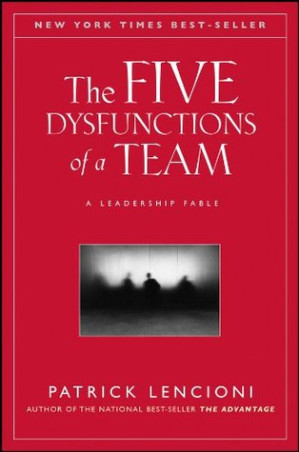Build vulnerability-based trust as your foundation
Team members who aren't vulnerable with one another cannot build genuine trust.

Book summary
by Patrick Lencioni
A leadership fable about the behaviors that undermine teamwork
Leadership fable about overcoming team dysfunction patterns
Topics
Read this book with your specific team in mind, using Readever to track which dysfunctions resonate most with your experience. After each chapter, pause to assess your team against that dysfunction and log one concrete action you can take. Use the AI-powered highlighting to identify trust-building exercises and conflict management frameworks that match your team's current challenges. Create a team assessment checklist in Readever to track progress across all five dysfunctions.
Things to know before reading
The Five Dysfunctions of a Team reveals why even the most talented teams often fail to reach their potential. Through a compelling leadership fable, Patrick Lencioni identifies five core dysfunctions that plague teams: absence of trust, fear of conflict, lack of commitment, avoidance of accountability, and inattention to results. The book provides practical tools and frameworks to diagnose and overcome these challenges, transforming dysfunctional groups into cohesive, high-performing teams.
Lencioni's five dysfunctions form a pyramid where each level depends on the one below it—from foundational trust to ultimate results.
Team members who aren't vulnerable with one another cannot build genuine trust.
Teams that fear conflict create environments where artificial harmony prevails and critical issues remain unaddressed.
Without conflict, it is impossible for team members to commit to decisions, creating ambiguity throughout the organization.
Team members must be willing to call their peers on performance or behaviors that might hurt the team.
Team members must put collective results ahead of individual goals, status, or ego.
Ready to continue? Launch the Readever reader and keep turning pages without paying a cent.
This summary gives you a diagnostic framework to identify and address the root causes of team dysfunction. You'll learn practical strategies to build trust, embrace healthy conflict, ensure commitment, enforce accountability, and focus on collective results—turning your team into your organization's ultimate competitive advantage.
Key idea 1
Team members who aren't vulnerable with one another cannot build genuine trust.
The first dysfunction—absence of trust—stems from team members' unwillingness to be vulnerable within the group. Without vulnerability-based trust, team members cannot admit weaknesses, ask for help, or acknowledge mistakes. Lencioni argues that trust isn't about predictability but about creating an environment where people feel safe to be vulnerable. Teams build this foundation through personal histories exercises, team effectiveness exercises, and personality profiling tools.
Remember
Key idea 2
Teams that fear conflict create environments where artificial harmony prevails and critical issues remain unaddressed.
The second dysfunction—fear of conflict—occurs when teams avoid ideological conflict to preserve artificial harmony. Lencioni distinguishes between destructive personal attacks and constructive ideological conflict focused on concepts and ideas. Teams that master conflict use tools like real-time permission, mining for conflict, and conflict resolution frameworks to ensure all perspectives are heard and debated thoroughly.
Remember
Key idea 3
Without conflict, it is impossible for team members to commit to decisions, creating ambiguity throughout the organization.
The third dysfunction—lack of commitment—arises when team members don't buy into decisions, leading to ambiguity and lack of direction. Lencioni emphasizes that commitment doesn't require consensus but rather clarity and buy-in. Teams overcome this dysfunction through techniques like cascading communication, deadlines with consequences, and contingency planning to ensure everyone understands and supports decisions.
Remember
Key idea 4
Team members must be willing to call their peers on performance or behaviors that might hurt the team.
The fourth dysfunction—avoidance of accountability—occurs when team members hesitate to hold each other accountable for behaviors and performance standards. Lencioni argues that peer-to-peer accountability is more immediate and effective than top-down accountability. Teams establish this through publication of goals and standards, simple and regular progress reviews, and team rewards that emphasize collective achievement.
Remember
Key idea 5
Team members must put collective results ahead of individual goals, status, or ego.
The fifth dysfunction—inattention to results—happens when team members prioritize individual goals, career advancement, or recognition over collective team success. Lencioni emphasizes that results-oriented teams make their goals public, reward results rather than activities, and keep score of progress. This requires team members to sacrifice personal agendas for the greater good of the team.
Remember
The Five Dysfunctions of a Team presents a leadership fable about a fictional technology company struggling with internal dysfunction. Through the story of Kathryn Petersen, a new CEO brought in to turn around a struggling executive team, Lencioni illustrates how the five dysfunctions manifest in real organizational settings.
The book combines narrative storytelling with practical business advice, making complex organizational dynamics accessible and actionable. Each dysfunction builds upon the previous one, creating a pyramid where trust forms the foundation and collective results represent the pinnacle of team effectiveness.
Open Readever's reader to highlight passages, ask the AI companion questions, and keep exploring without paying a cent.
Lencioni's storytelling approach makes complex organizational concepts accessible and memorable. The leadership fable format allows readers to see themselves in the characters and situations, making the lessons more impactful than traditional business books. The practical framework provides clear diagnostic tools and actionable solutions that teams can implement immediately.
Critical Reception: The Five Dysfunctions of a Team has become a modern business classic, praised for its practical approach to team development. It has sold over three million copies worldwide and is used by organizations ranging from Fortune 500 companies to startups and non-profits. The book's framework has been adopted by leadership development programs globally.
Team leaders and managers seeking to improve team performance
Executive teams experiencing communication or collaboration challenges
HR professionals designing team development programs
Entrepreneurs building cohesive startup teams
Anyone working in cross-functional or matrix organizations
Patrick Lencioni is the founder and president of The Table Group, a management consulting firm specializing in organizational health and executive team development. He is the author of twelve business books that have sold over seven million copies worldwide. Before founding The Table Group, Lencioni worked at Bain & Company, Oracle Corporation, and Sybase.
His consulting work focuses on helping leaders improve their organizational health through better teamwork, clarity, and communication. Lencioni's books are known for their accessible storytelling approach that combines business wisdom with practical application. He is a sought-after speaker and has worked with thousands of leadership teams across various industries.
Build your personalized reading stack
Download full-length ePubs in one click with personal cloud storage.
Blend AI-guided insights with tactile note-taking to accelerate reflection.
Follow curated reading journeys tailored to your goals and time budget.
Sync highlights across devices so lessons stick beyond the page.
Sign in to Readever to keep reading with AI guidance, instant summaries, and synced notes.
The Five Dysfunctions of a Team provides a powerful framework for transforming team dynamics. By addressing the foundational issues of trust, conflict, commitment, accountability, and results focus, teams can overcome the barriers that prevent them from reaching their full potential. The book's practical approach and memorable storytelling make it an essential resource for any leader committed to building cohesive, high-performing teams.
The five dysfunctions form an interconnected pyramid where each level depends on the one below it. Understanding this hierarchy is crucial for effective team intervention:
Many teams confuse polite conversation with genuine trust. True trust requires vulnerability and the ability to have uncomfortable conversations.
While conflict is necessary, it must remain focused on ideas, not personalities. Teams sometimes swing too far toward confrontation without proper frameworks.
Teams often waste time seeking unanimous agreement when what they need is clarity and buy-in from all members.
Peer-to-peer accountability is often more effective than top-down enforcement, yet many organizations default to hierarchical approaches.
Teams frequently focus on busyness rather than outcomes, rewarding effort over achievement.
Healthy teams demonstrate:
This framework provides a roadmap for transforming team dynamics from dysfunctional to cohesive, creating the foundation for sustained high performance.

Ray Kurzweil
Technological singularity and human-machine fusion

Paulo Freire
Revolutionary education theory empowering oppressed through critical consciousness

Jane Mayer
Investigates billionaire influence on American politics through hidden funding
Start reading The Five Dysfunctions of a Team for free and unlock personalized book journeys with Readever.